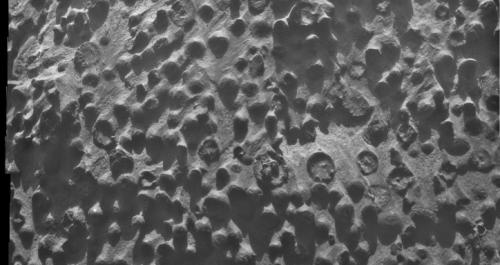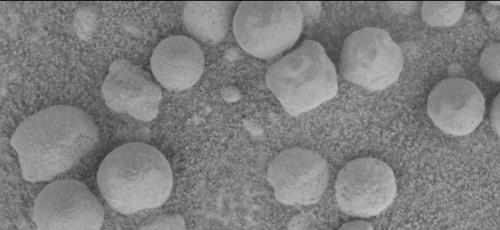The “Curiosity” rover which landed on Mars last month has been hogging the limelight of late, but the “Opportunity” rover which landed on Mars back in 2004 is still active and still getting things done.
The twin rovers Opportunity and Spirit landed on Mars in January 2004 with planned 90 day missions. Spirit went quiet for the last time on March 22 2010, but Opportunity is still working more than 8 and a half years later, having travelled over 35km from its landing site and studied many different craters and rock formations. Occasional “cleaning events”, mostly wind-storms, have helped prevent a fatal buildup of dust from covering Opportunity’s solar panels before its power output can drop below the minimum needed to stop critical parts from freezing in the Martian night.
On 14 September 2012, Opportunity encountered a rock formation unlike any yet seen on Mars or on Earth. As you can see in the photo at the top, it resembles a bunch of little spheres clustered on the rock. Initially, scientists thought that this was another case of the “blueberries” that Opportunity discovered back at its landing site in 2004 (see photo below). The “blueberries” were evidence that Mars used to have water: they were actually outcroppings of hematite (iron-bearing mineral) in the rock which had not been worn away by the actions of water when the surrounding rock had been.
According to Steve Squyres of Cornell University, chief investigator on the Opportunity mission, initial testing has revealed that the little spheres encountered by Opportunity at the Endeavour crater are “different in concentration. They are different in structure. They are different in composition. They are different in distribution.”
What are they? NASA doesn’t know yet. The only thing we do know is that once NASA works it out, we’ll know yet one more thing about the Red Planet thanks to a machine that was only scheduled to survive out there for 90 days. The new rover, Curiosity, has a heck of a legacy to live up to, and one which hasn’t stopped growing yet.
Images used in accordance with the JPL Image Use Policy.
Top image courtesy of NASA/JPL-Caltech/Cornell Univ./ USGS/Modesto Junior College
Second image courtesy of NASA/JPL

